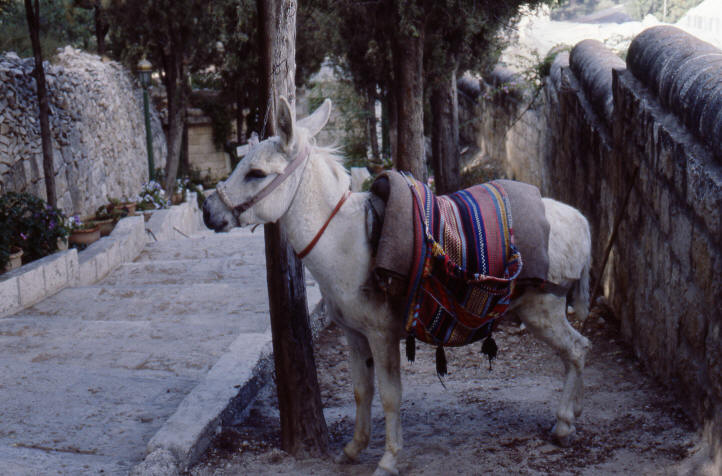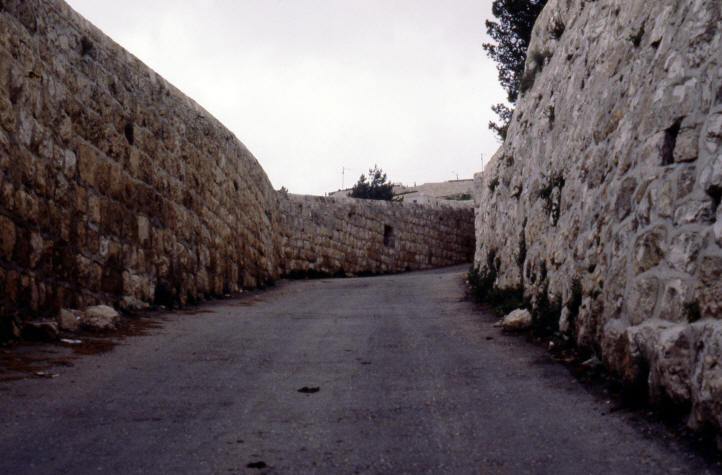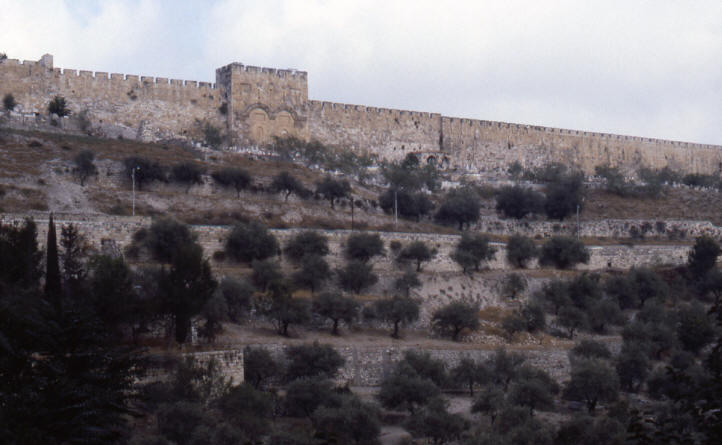

“The Sounds of Lent: Donkey’s Hoofs,
Cheering Crowds, and Jeering Crowds”
Luke 19:28-38
Pastor Kevin Vogts
Trinity Lutheran Church
Paola, Kansas
Palm Sunday—April 14, 2019
“The Sounds of Lent: Donkey’s Hoofs”
Grace to you and peace from God our Father and the Lord Jesus Christ.
Amen.
For our Wednesday evening Lent services this year, the messages have
been based on the theme, “The Sounds of Lent.” We are continuing that
theme during Holy Week, which begins this morning. On Maundy Thursday we
will mediate on the sounds at the Last Supper, singing, breaking bread, pouring
wine. On Good Friday we will consider the sounds of dice, which the
soldiers played beneath the cross while Christ hung dying, and his final death
cry from the cross. And we will celebrate Easter Sunday by meditating on
“The Rolling Stone—The Sound of Triumph!” This morning for Palm Sunday,
our message is based on the sounds of the donkey’s hoofs and the cheering crowds
and jeering crowds.
In today’s bulletin is a color insert with some photographs I took in
Jerusalem on Palm Sunday in 1980. It was a special experience to be in Jerusalem
for Holy Week. I was traveling with a group of Lutheran pre-seminary
college students, and we held Communion in Jerusalem on Maundy Thursday; on Good
Friday walked the Via Dolorosa, the traditional route Christ took to Calvary;
and early on Easter Sunday morning we attended a memorable sunrise service held
by the local Lutherans of Jerusalem on the Mount of Olives.
To celebrate Palm Sunday, I hiked up the Mount of Olives and walked down the modern road, which must be about the same route Jesus took into the holy city on the first Palm Sunday. It gave me goosebumps when part way down the Mount of Olives I came upon the scene in the first picture.

At the exact spot where Jesus would have mounted the donkey to ride
down into Jerusalem, there was a donkey, tied up alongside the road! There
was no one around, he didn’t seem to have an owner. He was just there, like he
was waiting for Jesus to arrive, reminiscent of the miraculously provided donkey
in today’s Gospel Reading, giving a perfect picture of what it must have been
like on that first Palm Sunday.
The conquering hero riding into the capital city was a common custom
and familiar scene in the ancient world. But, Jesus turns this well-known
event on its head, with some unexpected but very symbolic twists on the
traditional victory march of the conquering hero.
“At the hill called the Mount of Olives, he sent two of his disciples,
saying to them, ‘Go to the village ahead of you, and as you enter it, you will
find a colt tied there, which no one has ever ridden. Untie it and bring it
here.’” In the government and military there is a strict code of
established protocol, to which you are expected to rigidly adhere. Of
course, the proper protocol for a conquering hero is to enter his capital city
mounted on a stately white steed. Jesus certainly could have procured such
a proper aristocratic mount. He could have just as easily had his
disciples miraculously encounter stately steed and bring it to him for his
entrance into the city.
But, instead, he rides into Jerusalem on the exact opposite of a
thoroughbred, the most humble beast of burden, a lowly donkey. He did this
not out of necessity, not because that was the only animal available, but
purposely, to make a point of great symbolic significance.
The sound of the clip-clop of donkey’s hooves that first Palm Sunday
may have been very unusual for the entrance of a conquering hero, but for those
who knew their Hebrew Bible, it should not have been unexpected. For,
Zechariah prophesied exactly that in today’s Old Testament Reading: “Rejoice
greatly, O Daughter of Zion! Shout, Daughter of Jerusalem! See, your king
comes to you, righteous and having salvation, gentle and riding on a donkey.”
So, Christ’s unusual entry into Jerusalem upon a donkey was first of all the
fulfillment of prophecy, the gentle clip-clop of the donkey’s hooves testifying,
“This IS the long-awaited Lord, the promised Messiah.”
“The crowds that went ahead of him and those that followed shouted,
“Hosanna! Blessed is he who comes in the name of the Lord! Hosanna
in the highest!” The word hosanna is called a praise-shout, used in
worship in the Old Testament. It is a one-word prayer: “O Lord, Save!”
The crowds cry out, “Hosanna! O Lord, Save!” because that is WHO Jesus
is—the Lord—and WHY he has come—to save.
Some in the crowd that day mistakenly thought he had come to save them
from their national political enemy, the Romans, who for nearly a century had
occupied their land and oppressed their people. But, this conquering hero
has a much greater mission, against a much greater enemy. He is waging war
against the greatest enemy of all of humanity, the one Revelation describes as,
“that ancient serpent called the devil, or Satan, who leads the whole world
astray.”
“Hosanna! O Lord, Save!” That is WHO Jesus is, and WHY he has
come. We have been led astray into the ways of sin by that ancient serpent
called the devil, and we all deserve the punishment of death and damnation.
“Hosanna! O Lord, Save!” That is WHO Jesus is, and WHY he
has come, the LORD come to SAVE you. But, the sound of the clip-clop of
donkey’s hooves means he will save not through military might, but through
humble sacrifice. As Paul says in today’s Epistle Reading, “He humbled
himself and became obedient unto death—even death on a cross!”
“They took palm branches and went out to meet him.” The next photograph on the bulletin insert is a palm branch, like those the excited crowd waved and laid down on the road before Jesus to welcome him into Jerusalem on the first Palm Sunday. Such beautiful branches still cover palm trees all over Jerusalem today.

Like a ticker-tape parade giving world champions a hero’s welcome to
their home city, in the ancient world the waving of palm branches was a
traditional symbol of victory, welcoming Jesus in triumph to his holy city.
Paul says in 1st Corinthians, “Thanks be to God! He gives us the
victory through our Lord Jesus Christ. . . The last enemy to be destroyed
is death.” Jesus has won the victory for you the victory, conquered for
you over sin, Satan, and even death itself.
Just as he rode into the city not on the expected warrior’s white
steed, but on a humble donkey, he also took the cross, a symbol of death and
defeat, and he conquered through it, transforming it forever into a symbol of
life and victory. As the prayer before Communion in one of our services
says, “[You] made his cross a life-giving tree for all who trust in him.”
Amen.
“The Sounds of Lent: Cheering Crowds and Jeering
Crowds”
On the back side of the bulletin insert, the third photograph is the
road leading down the Mount of Olives into Jerusalem. Though this is the
modern road, it must be about the same route Jesus took nearly 2,000 years ago.

At the bottom of the road is the Kidron Valley, which separates Jerusalem from the Mount of Olives. The final photo is taken from down in the Kidron Valley, looking up at the eastern city walls of Jerusalem.

These walls date from the Middle Ages, but are very similar to the city
walls at the time of Christ. In this photo is the Golden Gate, which has
been blocked off for structural reasons, but is in the same place and very
similar to the gate Jesus rode through into the city.
On Palm Sunday CHEERING crowds line this road waving palm branches as
Jesus enters Jerusalem. But, on Good Friday just five days later, and
about a mile to the west, JEERING crowds line the road as he carries his cross
out of the city to Calvary.
It probably wasn’t the SAME people in those two crowds, who had changed
their minds about Jesus during the week. Today’s Gospel Reading says,
“When he came near the place where the road goes down the Mount of Olives, the
whole crowd of disciples began joyfully to praise God.” So, the CHEERING
crowds on Palm Sunday were Jesus’ disciples, but the Gospels indicate that the
JEERING crowds on Good Friday as he carried his cross to Calvary included only a
few of his disciples, who mourned and wailed for him. The jeers that day
came not from disappointed disciples, but from his enemies, whom the Gospels
report had long been plotting to kill him.
The sound of the jeering crowds on Good Friday represents the
opposition and ridicule and scorn that Christ and his Gospel and his followers
will ALWAYS face from a hostile world. As Paul says in 1st Corinthians,
“For the message of the cross is foolishness to those who are perishing, but to
us who are being saved it is the power of God.”
We see in the news disturbing stories about the opposition and ridicule
and scorn that Christ, and his Gospel, and his followers still face in our world
today. Persecution of Christians has recently increased dramatically in
parts of the Middle East, Africa, and Asia, with thousands put to death every
year because of their faith. But, it is surprising how prevalent such
hostility is even in western nations, with mostly Christian populations.
All across Europe, there is an outbreak right now of Christian churches being
destructively vandalized. And just last month a Canadian Christian
minister was stabbed on live television, right during the middle of a service
broadcast from Canada’s largest church, a famous landmark in Montreal.
Even here in our own land, Christians face opposition and ridicule and
scorn for upholding Christian beliefs and the Bible’s teachings. But, none
of that should really be surprising. As Jesus warned his disciples at the
Last Supper, “If they persecuted me, they will persecute you also.” “In
fact,” Paul tells Timothy, “everyone who wants to live a godly life in Christ
Jesus will be persecuted.”
“To this you were called,” Peter says, “because Christ suffered for
you, leaving you an example, that you should follow in his steps.” The
contrast of the CHEERING crowds on Palm Sunday and the JEERING crowds on Good
Friday is a reminder to us of Christ’s call to take up our cross and faithfully
follow him. And, if necessary, to endure for him the world’s opposition
and ridicule and scorn.
As Hebrews encourages us, “Let us fix our eyes on Jesus, the author and
perfecter of our faith, who for the joy set before him endured the cross,
scorning its shame, and sat down at the right hand of the throne of God.
Consider him who endured such opposition from sinful men, so that you will not
grow weary and lose heart.”
Return to Top | Return to Sermons | Home | Email Church Office